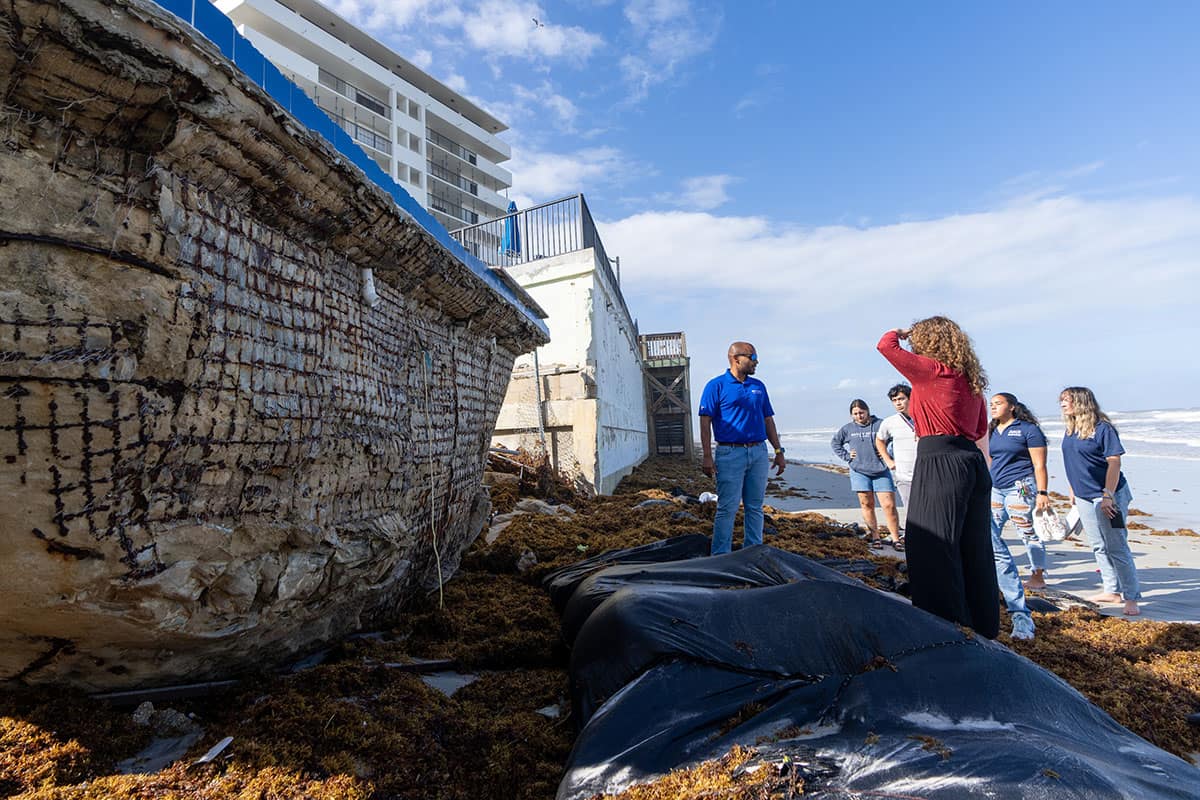To Protect Coast, Embry-Riddle, Bethune-Cookman and UCF Team Proposes ‘Living Seawall’

Sand dunes anchored with native vegetation have long been nature’s best defense against the powerful surge of the ocean and the erosion wrought by coastal storms. Drawing inspiration from this phenomenon, Embry-Riddle researchers, in collaboration with Bethune-Cookman University and the University of Central Florida, are developing a “living seawall” to restore and protect stretches of the Volusia County coast that have been battered and damaged by hurricanes.
Unlike solid, vertical seawalls — which accelerate erosion — a living seawall is overlaid with rocks, sand and native plants. This design allows the living seawall to perform like natural dunes and buffer storm surge and high winds, as well as to increase habitat for threatened species like sea turtles and shorebirds.
“We’re trying to do something sustainable and long-lasting for the community and at the same time create habitat,” said Dr. Siddharth Parida, assistant professor in the Department of Civil Engineering and principal investigator on the project. Parida and his fellow researchers are actively seeking to involve representatives of government agencies, groups involved in coastline preservation and members of the community in the project.
Living Seawall Workshops
Dr. Parida and his team are holding two workshops to educate the public about the groundbreaking “living seawall” project. Residents, property owners, environmentalists, government representatives and others interested in learning more about the project are encouraged to attend. The first workshop is today, Nov. 13, from 5:30 p.m. to 7:30 p.m. at the Brannon Center in New Smyrna Beach. The second is on Wednesday, Nov. 20, from 5:30 p.m. to 7:30 p.m. at the Ponce Inlet Community Center in Ponce Inlet.
Parida received a $75,000 grant from the National Science Foundation to fund the project’s preliminary stage. This includes identifying a site for the seawall and determining a design for building it based on its location and research-based technical assessments.
The project’s first stage will include four community engagement workshops.
Co-principal investigators on the first stage of the project include Dr. Stephen Medeiros, an assistant professor in Embry-Riddle’s Department of Civil Engineering; Dr. Hyun Cho and Kelly San Antonio from Bethune-Cookman University; and Dr. Georgios Apostolakis of the University of Central Florida (UCF). Representatives of Volusia County, the Florida Forest Service and the Riverside Conservancy, a local environmental organization, are also among the core group of collaborators.
Once a location and a plan for the living seawall are developed, the project could be eligible for a much larger grant of $1 million for actual construction.
Although a final design for the seawall is not yet developed, it will incorporate a solid wall with an underground foundation, fronted by riprap, or loose stones, and sand. The wall will also include the deep-rooted vegetation found on natural dunes.

Professor Siddharth Parida explores Daytona Beach’s damaged shoreline, which has been battered by a series of hurricanes. (Photo: Embry-Riddle/David Massey)
“Dune resilience needs to be better understood and integrated into adaptive management and restoration because solid-armored shorelines pose long-term detrimental effects on the hurricane-prone regions,” Parida said.
Michael Morales, a senior in Civil Engineering who is the student lead for engineering development on the project, said he thinks the project “reshapes the narrative around resilience and sustainability in infrastructure.”
“We’re looking at how manmade coastal structures have failed to live up to design or to consider the ramifications of an evolving climate,” he said. “The idea of living seawalls being adopted by coastal communities ties together social and environmental values while putting nature at the center of practical, effective design.”
Izel Tuncer, an Aerospace Engineering senior who is the community outreach student lead on the project, said that she was “grateful for the opportunity to make a meaningful impact,” on a project that holds “tremendous value as our coastlines face increasing threats.”
Cho, professor of Integrated Environmental Science at Bethune-Cookman, emphasized that bringing the project to fruition will require extensive collaboration.
She said the project “will require facilitating community workshops that bring together a diverse array of stakeholders.” By engaging such a wide range of interested groups, she said, “we can develop solutions that balance ecological, social and economic goals.”
Kelli McGee, executive director of the Riverside Conservancy, said her organization came on board as a community partner to help with public outreach.
McGee noted that more than 20 miles of shoreline in Volusia County were severely eroded by Hurricanes Ian and Nicole in 2022. In the aftermath of the storms, the wreckage included smashed concrete seawalls and swimming pools left dangling after the ground beneath them was swept away. The 2022 storms caused damage estimated at $500 million in Volusia County, and county leaders said Hurricane Milton, which struck last month, caused an additional $267 million.
Parida and Medeiros will conduct resiliency and storm surge modeling to provide a restoration that is customized to the chosen site — and to study shoreline dynamics and how the living seawall solution could be scaled and repeated at other sites as well. Undergraduate and graduate students will also participate in the research.
For more information about the living seawall project and associated community workshops, contact Dr. Siddharth Parida at paridas@erau.edu or +1 (386) 226-7299.

 Michaela Jarvis
Michaela Jarvis